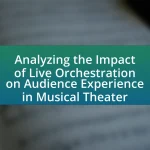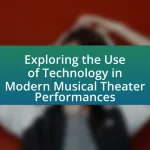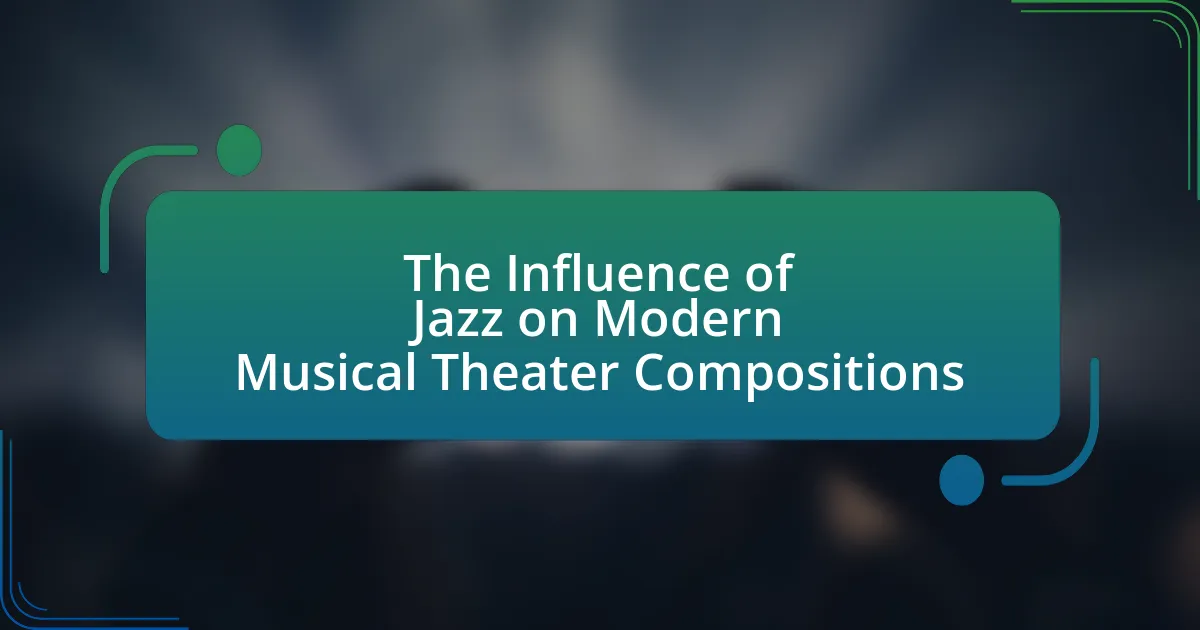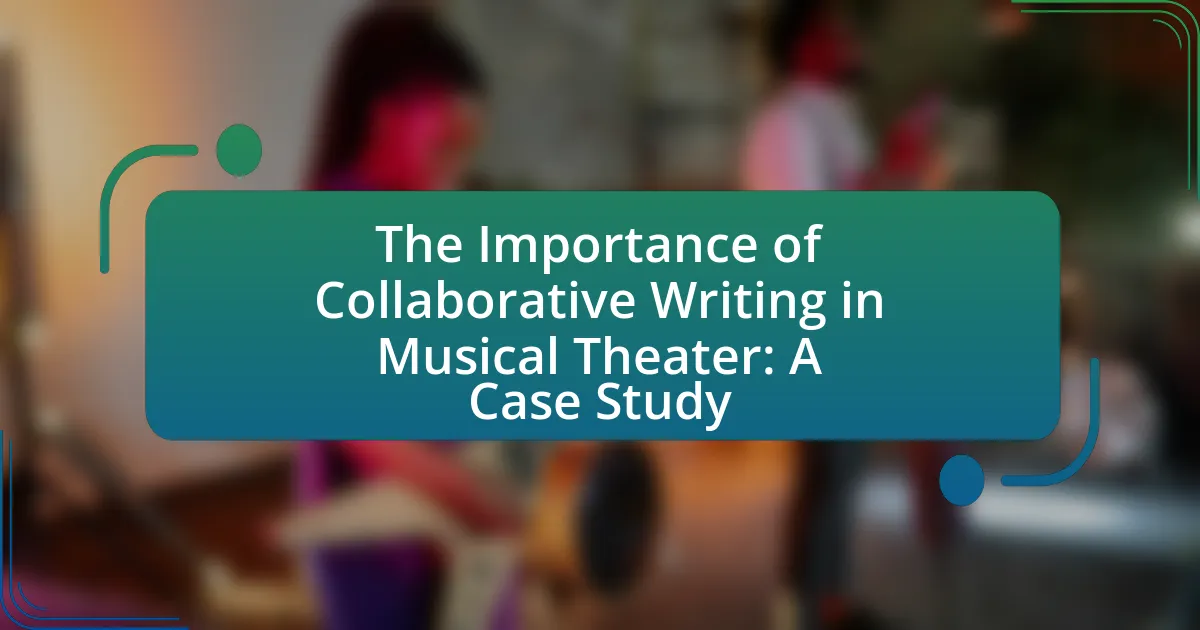The article examines the critical role of orchestration in enhancing musical theater narratives. It highlights how orchestration deepens emotional impact, supports storytelling, and shapes character development through the strategic use of various instruments and musical techniques. Key elements discussed include instrumentation choices, dynamics, and thematic development, with historical examples from notable musicals such as “West Side Story,” “Les Misérables,” and “Hamilton.” The article also addresses best practices for composers in balancing orchestration with vocal performances and avoiding common pitfalls, emphasizing the importance of orchestration in creating immersive and emotionally resonant theatrical experiences.
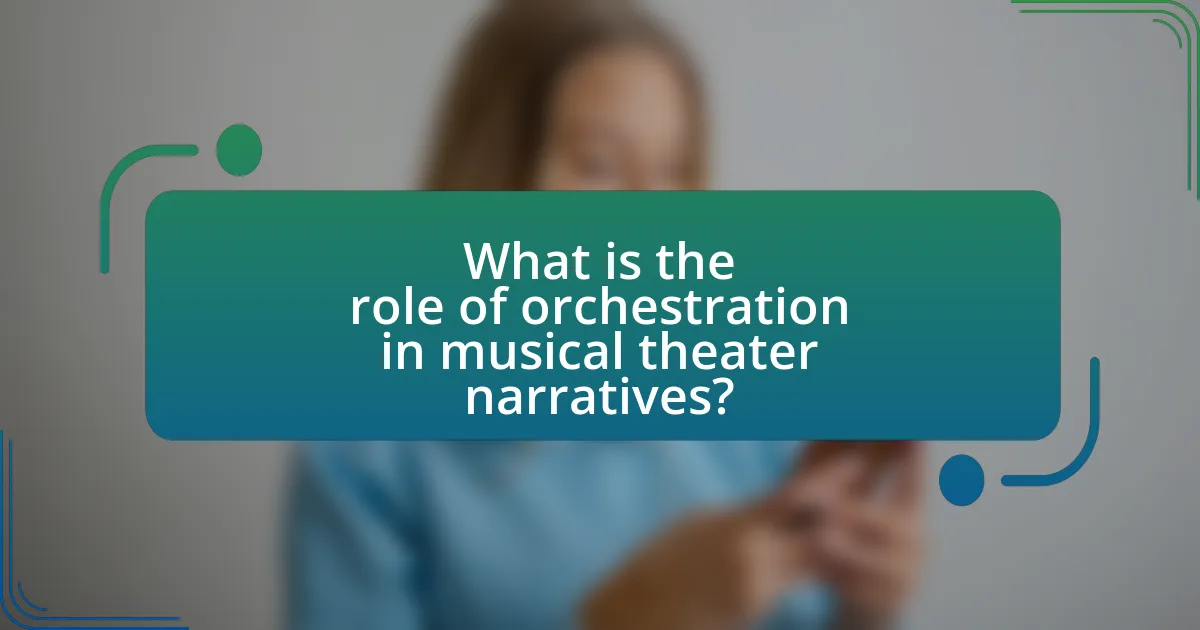
What is the role of orchestration in musical theater narratives?
Orchestration in musical theater narratives serves to enhance emotional depth and support storytelling through music. It achieves this by using a variety of instruments to create distinct soundscapes that reflect characters’ emotions and plot developments. For instance, the use of strings can evoke tenderness, while brass may signify triumph or conflict. This strategic use of orchestration not only complements the lyrics and dialogue but also helps to establish the mood and atmosphere of each scene, guiding the audience’s emotional response. Historical examples, such as the orchestration in “West Side Story” by Leonard Bernstein, demonstrate how varied instrumentation can underscore dramatic moments, thereby reinforcing the narrative’s themes and character arcs.
How does orchestration contribute to storytelling in musical theater?
Orchestration significantly contributes to storytelling in musical theater by enhancing emotional depth and character development through musical textures and instrumentation. The choice of instruments and their arrangement can evoke specific moods, highlight dramatic moments, and reflect character emotions, thereby advancing the narrative. For example, in “Les Misérables,” the use of strings during emotional solos amplifies the characters’ internal struggles, while brass instruments can signify conflict or triumph. This strategic orchestration not only supports the lyrics but also creates an immersive experience that deepens audience engagement with the story.
What elements of orchestration enhance emotional impact in narratives?
Elements of orchestration that enhance emotional impact in narratives include instrumentation, dynamics, and harmonic choices. Instrumentation allows composers to select specific instruments that evoke particular emotions; for example, strings can convey warmth and intimacy, while brass can evoke power and triumph. Dynamics, or the variations in loudness, create tension and release, guiding the audience’s emotional journey. Harmonic choices, such as the use of dissonance or consonance, can elicit feelings of tension or resolution, respectively. Research indicates that these orchestral elements significantly influence audience emotional responses, as demonstrated in studies analyzing the correlation between musical elements and emotional perception in theater.
How does orchestration shape character development in musical theater?
Orchestration shapes character development in musical theater by using instrumentation and musical texture to reflect and enhance a character’s emotional journey. For instance, specific instruments can symbolize a character’s traits or experiences; a solo violin may represent vulnerability, while a full brass section can convey strength or conflict. This technique allows the audience to connect more deeply with the character’s internal struggles and transformations. Historical examples include the use of woodwinds in “The Phantom of the Opera” to evoke the haunting nature of the Phantom’s character, illustrating how orchestration directly influences audience perception and understanding of character arcs.
Why is orchestration considered a vital component of musical theater?
Orchestration is considered a vital component of musical theater because it enhances the emotional depth and storytelling of the performance. The arrangement of music for various instruments allows for a richer sound palette, which supports the narrative and character development. For instance, in productions like “Les Misérables,” the orchestration underscores key emotional moments, amplifying the audience’s connection to the characters and their journeys. This strategic use of instrumentation not only complements the vocal performances but also creates an immersive atmosphere that is essential for engaging the audience in the theatrical experience.
What historical context supports the importance of orchestration in musicals?
The historical context that supports the importance of orchestration in musicals is rooted in the evolution of musical theater from the early 20th century, particularly during the Golden Age of Broadway. During this period, composers like Richard Rodgers and Oscar Hammerstein II began to integrate orchestration as a vital storytelling tool, enhancing emotional depth and character development. For instance, the orchestration in “Oklahoma!” (1943) was pivotal in conveying the narrative’s themes and emotions, showcasing how the musical score could elevate the overall experience. This trend continued with works like “West Side Story” (1957), where Leonard Bernstein’s orchestration played a crucial role in reflecting the cultural tensions and character dynamics, further solidifying orchestration’s significance in shaping musical narratives.
How has orchestration evolved in musical theater over time?
Orchestration in musical theater has evolved significantly from the early 20th century to the present day, transitioning from simple piano accompaniments to complex arrangements involving diverse instrumentation. Initially, orchestration primarily featured small ensembles or solo piano, as seen in early works like “Show Boat” (1927), which utilized a limited number of instruments to support vocal performances. Over time, the incorporation of larger orchestras became prevalent, particularly during the Golden Age of Broadway in the 1940s and 1950s, exemplified by productions like “Oklahoma!” (1943) and “West Side Story” (1957), which showcased rich, full orchestrations that enhanced storytelling through musical motifs and thematic development.
The late 20th century introduced further innovation with the integration of electronic instruments and synthesized sounds, allowing for new textures and effects, as demonstrated in shows like “Rent” (1996) and “Hamilton” (2015). This evolution reflects a broader trend in musical theater where orchestration not only supports the narrative but also plays a crucial role in character development and emotional resonance, adapting to contemporary musical styles and audience expectations. The shift towards more diverse and innovative orchestration techniques has fundamentally transformed how stories are told in musical theater, making it a dynamic and evolving art form.

What techniques are used in orchestration to enhance narratives?
Techniques used in orchestration to enhance narratives include thematic development, instrumentation choices, and dynamic contrasts. Thematic development allows composers to create motifs that represent characters or emotions, thereby deepening the audience’s connection to the narrative. Instrumentation choices, such as using strings for tenderness or brass for power, evoke specific moods and support the storytelling. Dynamic contrasts, including variations in volume and intensity, help to underscore dramatic moments and transitions within the narrative. These techniques collectively contribute to a more immersive and emotionally resonant experience in musical theater.
How do different orchestral arrangements affect the mood of a scene?
Different orchestral arrangements significantly influence the mood of a scene by altering the emotional texture conveyed through instrumentation, harmony, and dynamics. For instance, a full orchestral arrangement with strings, brass, and woodwinds can create a rich, lush atmosphere that evokes feelings of grandeur or nostalgia, while a sparse arrangement featuring only piano or solo instruments may evoke intimacy or tension. Research by the University of Southern California highlights that specific instrument combinations, such as the use of violins and cellos, can elicit feelings of sadness or longing, while brass instruments often convey triumph or excitement. This demonstrates that orchestral arrangements are not merely background elements but are integral to shaping the audience’s emotional response to the narrative in musical theater.
What are the common orchestral instruments used in musical theater?
Common orchestral instruments used in musical theater include violins, cellos, flutes, clarinets, trumpets, trombones, and percussion instruments. These instruments are essential for creating the rich, dynamic soundscapes that enhance the storytelling in musical theater productions. For instance, strings provide emotional depth, woodwinds add color, brass instruments contribute power, and percussion establishes rhythm, all of which are crucial for engaging the audience and supporting the narrative.
How do dynamics and tempo variations influence narrative pacing?
Dynamics and tempo variations significantly influence narrative pacing by controlling the emotional intensity and flow of a story. When dynamics shift from soft to loud, it can heighten tension or excitement, propelling the narrative forward. Conversely, slower tempos can create moments of reflection or suspense, allowing audiences to absorb critical plot developments. For instance, in musical theater, a sudden increase in tempo during a climactic scene can energize the audience and enhance the urgency of the narrative, while a gradual deceleration can evoke a sense of melancholy or contemplation, effectively manipulating the pacing to align with the story’s emotional arc.
What role does orchestration play in integrating music and lyrics?
Orchestration plays a crucial role in integrating music and lyrics by enhancing the emotional impact and narrative coherence of a musical piece. It involves the arrangement of musical elements to complement the lyrical content, ensuring that the instrumentation supports the themes and emotions conveyed in the lyrics. For instance, in musical theater, specific orchestral choices can amplify the mood of a scene, such as using strings for tenderness or brass for triumph, thereby creating a seamless connection between the music and the story being told. This integration is essential for engaging the audience and conveying the intended message effectively, as evidenced by successful musicals like “Hamilton,” where orchestration intricately weaves together rap lyrics and diverse musical styles to enhance storytelling.
How does orchestration support lyrical themes and motifs?
Orchestration supports lyrical themes and motifs by enhancing emotional depth and reinforcing narrative elements through instrumental color and texture. For instance, specific instruments can evoke particular feelings; strings often convey warmth or sadness, while brass can signify triumph or power. This alignment between orchestration and lyrics creates a cohesive storytelling experience, as seen in productions like “Les Misérables,” where the orchestration underscores the characters’ emotional journeys, amplifying the impact of the lyrics. Additionally, the use of motifs—distinct musical phrases associated with characters or themes—can be woven into the orchestration, providing continuity and reinforcing the narrative arc throughout the performance.
What techniques are used to create musical motifs for characters?
Techniques used to create musical motifs for characters include thematic development, instrumentation choices, and harmonic structures. Thematic development involves crafting a distinct melody that embodies a character’s traits or emotions, allowing audiences to associate specific musical phrases with that character. Instrumentation choices enhance the motif’s emotional impact; for example, using strings for a romantic character or brass for a villain can convey personality traits effectively. Harmonic structures, such as using minor keys for tension or major keys for joy, further reinforce the character’s narrative arc. These techniques are widely employed in musical theater to deepen audience engagement and understanding of character dynamics.

How can orchestration be effectively utilized in musical theater productions?
Orchestration can be effectively utilized in musical theater productions by carefully selecting instruments and arranging music to enhance the emotional impact of the narrative. This involves using specific instrument combinations to reflect character emotions and plot developments, as seen in productions like “Les Misérables,” where orchestration underscores the tension and drama of the story. Additionally, effective orchestration can create a cohesive sound that supports the overall theme, as demonstrated in “Hamilton,” where diverse musical styles are orchestrated to reflect the cultural context of the characters. By aligning orchestration with the narrative arc, productions can elevate the audience’s experience and deepen their connection to the story.
What best practices should composers follow when orchestrating for theater?
Composers should prioritize clarity and balance when orchestrating for theater. Clarity ensures that the musical elements support the narrative without overwhelming the dialogue or action on stage. Balance involves distributing musical textures and dynamics appropriately among instruments to create a cohesive sound that enhances the emotional impact of the performance.
Additionally, composers should consider the range and capabilities of the performers, ensuring that the orchestration complements their vocal strengths. Historical practices, such as those used by Stephen Sondheim and Leonard Bernstein, demonstrate that effective orchestration can elevate storytelling by aligning musical motifs with character development and plot progression.
How can composers balance orchestration with vocal performances?
Composers can balance orchestration with vocal performances by carefully arranging instrumental parts to support rather than overshadow the singers. This involves using dynamics, texture, and instrumentation that complement the vocal lines, ensuring clarity and emotional impact. For instance, in musical theater, composers often employ lighter orchestration during vocal solos to allow the lyrics and melody to be the focal point, while fuller orchestration can be used in ensemble numbers to create a rich soundscape. Historical examples include Stephen Sondheim’s works, where he skillfully balances orchestration to enhance the narrative without detracting from the vocal performances.
What are the common pitfalls to avoid in orchestration for musicals?
Common pitfalls to avoid in orchestration for musicals include overcomplicating arrangements, neglecting the vocal lines, and failing to consider the emotional context of the narrative. Overcomplicating arrangements can lead to a cluttered sound that distracts from the story, as seen in productions where excessive instrumentation overshadows the lyrics. Neglecting vocal lines often results in orchestration that does not support or enhance the singers, which can diminish the impact of key moments in the musical. Additionally, failing to align orchestration with the emotional context can create dissonance between the music and the narrative, undermining the audience’s connection to the characters and their journeys.
What are some examples of successful orchestration in notable musicals?
Successful orchestration in notable musicals includes “Hamilton,” where Lin-Manuel Miranda’s blend of hip-hop and traditional musical elements creates a dynamic sound that enhances the storytelling. Another example is “The Phantom of the Opera,” where Andrew Lloyd Webber’s use of a full orchestra, including strings and brass, intensifies the emotional impact of the narrative. Additionally, “West Side Story” features Leonard Bernstein’s innovative orchestration that combines jazz influences with classical elements, effectively conveying the characters’ emotions and the tension of the story. These examples demonstrate how orchestration plays a crucial role in enhancing the narratives of these musicals.
How did orchestration enhance the narrative in “Hamilton”?
Orchestration in “Hamilton” significantly enhanced the narrative by blending diverse musical styles, which reflected the characters’ backgrounds and emotions. The use of hip-hop, R&B, and traditional musical theater elements allowed for a dynamic storytelling approach, making historical events more relatable and engaging. For instance, the character of Alexander Hamilton is often accompanied by fast-paced rap, symbolizing his ambitious and driven nature, while softer melodies underscore moments of vulnerability, such as his relationship with Eliza. This strategic orchestration not only supports the plot but also deepens the audience’s emotional connection to the characters, illustrating how music can serve as a narrative device in theater.
What orchestration techniques were pivotal in “The Phantom of the Opera”?
The orchestration techniques pivotal in “The Phantom of the Opera” include the use of a large orchestra, blending of various instrumental timbres, and the incorporation of motifs associated with characters and themes. The expansive orchestration, featuring strings, brass, woodwinds, and percussion, creates a rich soundscape that enhances the emotional depth of the narrative. Specific techniques, such as the use of leitmotifs, allow the music to reflect the psychological states of characters, particularly the Phantom and Christine. This approach is evident in the recurring themes that accompany their interactions, reinforcing the dramatic tension throughout the musical. Additionally, the dynamic contrasts and orchestral textures contribute to the overall atmosphere, making the music integral to the storytelling.
What practical tips can enhance orchestration in musical theater?
To enhance orchestration in musical theater, composers should focus on creating a balanced instrumentation that supports the narrative and emotional arc of the story. This involves selecting instruments that reflect the characters and themes, ensuring that the orchestration complements the vocal lines without overpowering them. For instance, using strings to convey tenderness or brass for moments of triumph can effectively underscore the emotional landscape. Additionally, incorporating dynamic contrasts and varied textures can maintain audience engagement and highlight key moments in the performance. Research indicates that effective orchestration can significantly impact audience perception and emotional response, as seen in successful productions like “Hamilton,” where diverse instrumentation plays a crucial role in storytelling.

